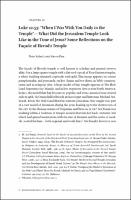Please use this identifier to cite or link to this item:
https://hdl.handle.net/20.500.12202/8464| Title: | 10 Luke 22:53: “When I Was With You Daily in the Temple”—What Did the Jerusalem Temple Look Like in the Time of Jesus? Some Reflections on the Façade of Herod’s Temple |
| Authors: | Schertz, Peter Fine, Steven Schertz, Peter Fine, Steven |
| Keywords: | art |
| Issue Date: | 2016 |
| Publisher: | Brill |
| Citation: | Fine, S. (2016). 10 Luke 22:53: “When I Was With You Daily in the Temple”—What Did the Jerusalem Temple Look Like in the Time of Jesus? Some Reflections on the Façade of Herod’s Temple. In P. Schertz & S. Fine (eds.) "The Gospels in First-Century Judaea." Brill, 136–144 , https://doi.org/10.1163/9789004305434_012 . |
| Abstract: | The façade of Herod’s temple is well known to scholars and general viewers alike. It is a large square temple with a flat roof typical of Near Eastern temples, a white building trimmed copiously with gold. This image appears on tourist paraphernalia, and postcards, on key chains and tee-shirts, in bible commentaries and in religious sites. A large model of this temple appears at The Holy Land Experience in Orlando, and in less expansive sites across North America. In fact, the model that has become so popular and even canonical was created only in 1966, the brainchild of Israeli archaeologist and historian, Michael Avi- Yonah. Set in the Holy Land Hotel in western Jerusalem, this temple was part of a vast model of Jerusalem during the years leading up to the destruction of the city by the Roman armies of Vespasian and Titus in 70 CE.1 Avi-Yonah was working within a tradition of temple models that reaches back centuries, but which had gained momentum with the rise of Zionism and the series of models created for fairs—both regional and world fairs.2 Avi-Yonah’s, however, was a permanent exhibition, the equal of Mussolini’s model of imperial Rome at the Museo della Civiltà Romana.3¶ Avi-Yonah’s model was a creative act of profound scholarship, erudition and caution4 A historian of the first order, Avi-Yonah pieced together scattered references to the temple in the writings of Josephus (who had served in Herod’s temple as a priest), memories preserved in later rabbinic literature and the New Testament along with his deep knowledge of both Herodian architecture at Masada, Herodion, Caesarea Maritima and Sebastia and of Roman architecture and architectural writings from the age of Augustus, Herod’s patron.5 The resulting model was so successful, that it has become the iconic image of the Second temple for Jews and Christians worldwide.6 A mark of its success is the large number of models constructed in recent years based upon Avi-Yonah’s, yet “fixing” this standard by imagining a Temple that conforms to the beliefs of each interpreter.7 |
| Description: | Scholarly book chapter |
| URI: | https://doi.org/10.1163/9789004305434_012 https://hdl.handle.net/20.500.12202/8464 |
| ISBN: | 978-90-04-30543-4 |
| Appears in Collections: | Bernard Revel Graduate School of Jewish Studies (BRGS): Faculty Publications |
Files in This Item:
| File | Description | Size | Format | |
|---|---|---|---|---|
| Schertz Fine 10_Luke_22_53_When_I_Was_With_You_Daily.pdf | 80.4 kB | Adobe PDF |  View/Open |
This item is licensed under a Creative Commons License

